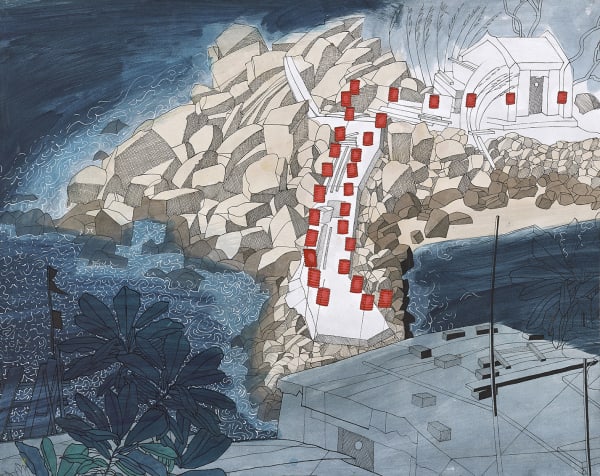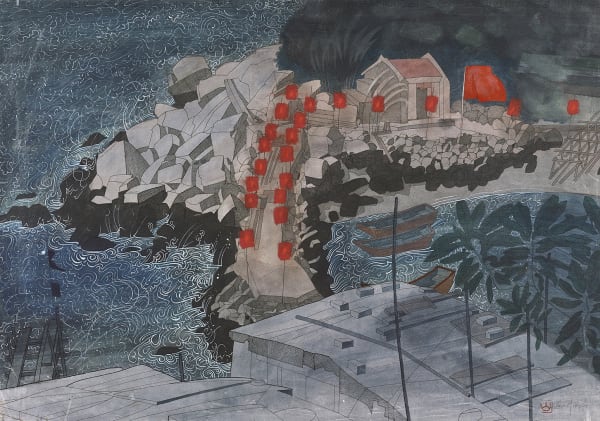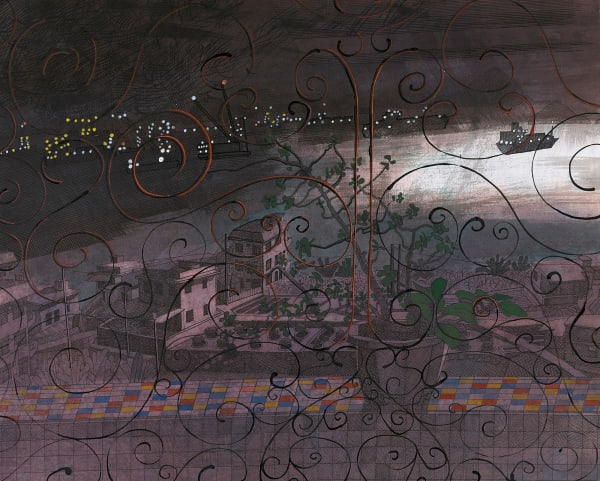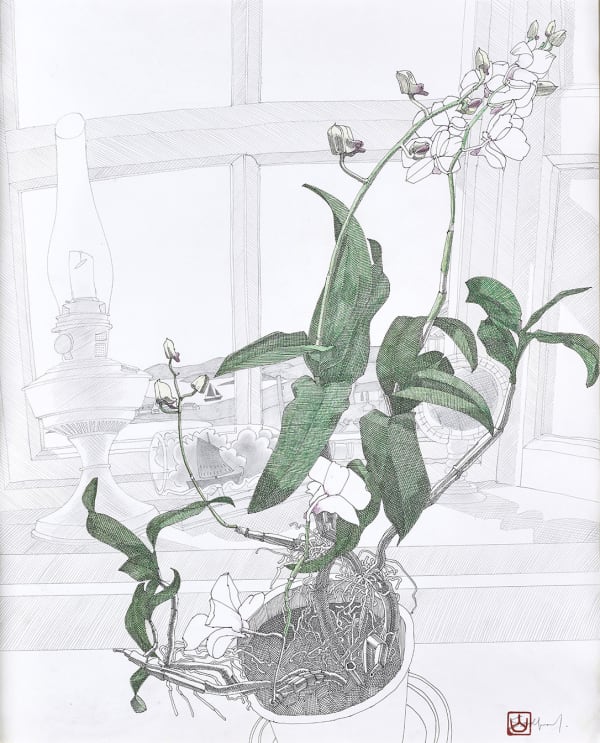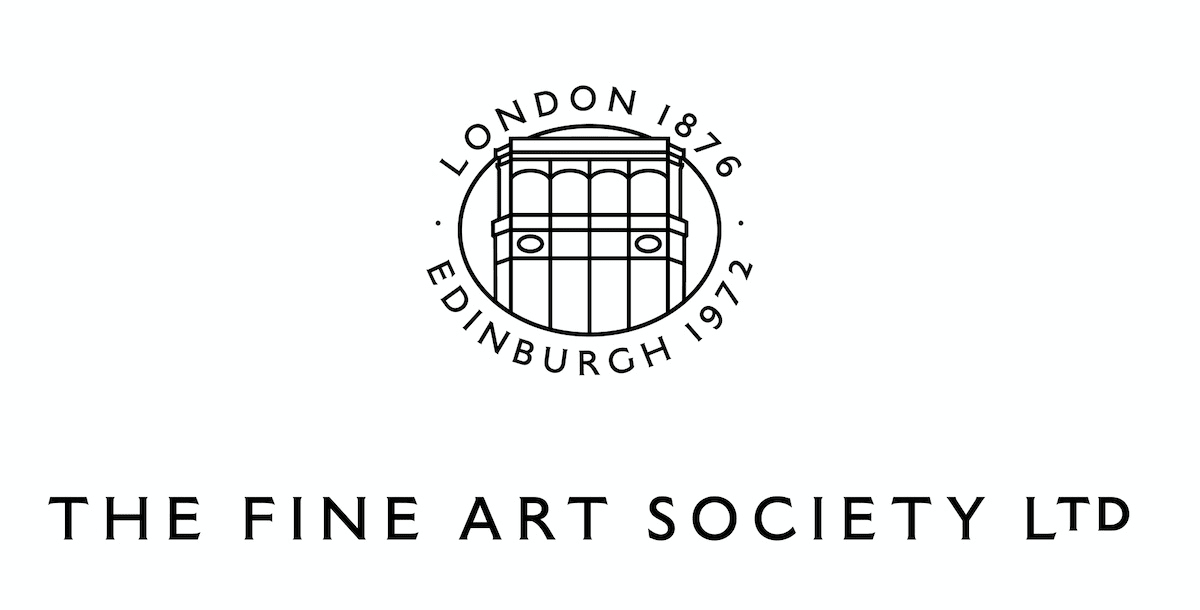RON SANDFORD
2 - 30 AUGUST
-
-

-
-
-
-
This is a village that is loosely translated as Banyon Tree Bay (Luk Chau Tsuen). There is a small harbour that was used at this point for keeping sampans and dragon boats. You can see the preparations for the dragon boat festival already with the lanterns lit up. In the foreground are the squatters huts, immaculately built out of packing cases. Ron recalls seeing beautifully turned-out school children on their way to Hong Kong island and then returning here to this, where they lived free.
-
-
Encouraged by Norman Foster to draw the newly built HSBC building in Hong Kong (completed 1985), Ron found himself in a city that presented the change of pace and scene he needed: a break from commissioned work in the UK, cheap living, low taxes and bountiful material. Upon meeting an ex-pupil, Meilo So – who later became his wife – he settled in Lamma. Ron was drawn to Chinese vernacular architecture. A recurrent motif of mid-stream operations, the at-sea loading and unloading of containers, in the shipping lanes just off Lamma forms the backdrop to many of his pictures from this time. Brooding hulks contrast with decorative domestic environments.
-
-

-
-

-
-
-
-

-
On returning to London Sandford fulfilled his valedictory commission to draw the Millennium Bridge and then moved to Yell, a place he had first visited in the 1980s. By then he and Meilo had a two year old daughter, Ming. That it was also a trout fishing paradise, he concedes, ‘weighed heavily’. Freed from deadlines and exacting commissions, he followed his own inclinations.
From his studio in The Galley Shed, he draws the everyday, every day: still life, landscape and portrait in pencil, pen, ink and watercolour. Not ordinary, but charged with attitude.
-
-
-
-
Ron has always enjoyed drawing flowers and plants. This goes back to when he studied and probably partly to his friendship with Edward Bawden, a friendship that was struck up at the Royal College of Art. His Shetland still lifes are often depicted from his window at home, looking over the Bluemull Sound to the cliffs on the opposite side.
Still lifes wall papers, patterns, layers and layers are a motif in Ron's work. This comes from his childhood: when their flat was bombed in WW2 they were rehoused in a council house. Upon arriving, it was stark and empty and his mother resourcefully went to the local decorators and acquired some pre-war wall paper, art deco wall paper. Ron lived amongst all these abstract patterns, pineapples, all sorts of exotic paper. Upon going to Glasgow to study he then saw the work of Stanley Spencer and Vuillard and others and this just opened the flood gate for him. Ever since he has continued to embrace pattern.
-
-
Ron grew up in Greenock, the son of a marine engineer. He was surrounded by plans and elevations. Through war-time rationing, his father brought home disused blueprints for tablecloths. The pale blue background and white skeletal drawings of cross-sections and elevations were, he recalls, ‘soaked up with my porridge’. Upon leaving Greenock High School he trialled at a local architect’s office. The routine of it was deadening and he chucked it within weeks. From 1956-60 he attended Glasgow School of Art in the etching and engraving department, soon to be taken over by Philip Reeves. He was still liable for National Service but, encouraged by Reeves, he applied for and was accepted into the Royal College of Art. For three years he studied in the Graphics department and it was there he became friends with Edward Bawden. Conversations about drawing and plants provided rich common ground. Bawden, who was in his 70s, invited Ron to join him on a drawing trip to Istanbul. Bawden held Ron in high esteem, dubbing him ‘the wizard of the ink bottle’ and helped him secure a part-time teaching job at the College. Through the 60s and 70s he taught part time at the Central School of Art and Design, the Royal College of Art, St. Martin’s School of Art and Brighton School of Art. From the 1960s he was a corresponding editor of Ambit, a quarterly art and literary publication. Each issue over 40 years included his drawings and around 80 poets have sat for their Sandford portraits.
For 30 years, Ron illustrated books and newspapers and undertook large scale architectural commissions such as Bishopsgate, London. He was commissioned by the likes of the V&A, Longman publishers and architects such as Norman Foster and Richard Rogers. His oil-rig series, commissioned by Mobil Oil saw him stay on a rig for a month where he could observe the technical details of an offshore installation alongside profiles of the roustabouts. Although he put his own stamp on the work, he had to respond to the needs and demands of the commissioning agents.
-

-
-
 Ron SandfordFishplate & Filletsstamped with artist's sealoil and pencil on canvasboard16 x 12 inchesRon Sandford, Fishplate & Fillets£ 850.00
Ron SandfordFishplate & Filletsstamped with artist's sealoil and pencil on canvasboard16 x 12 inchesRon Sandford, Fishplate & Fillets£ 850.00 -

-
-
If you would like to discuss artworks by Ron Sandford,
or would like us to take additional photographs
please contact us through the enquiry button below
CONTACT US
-



